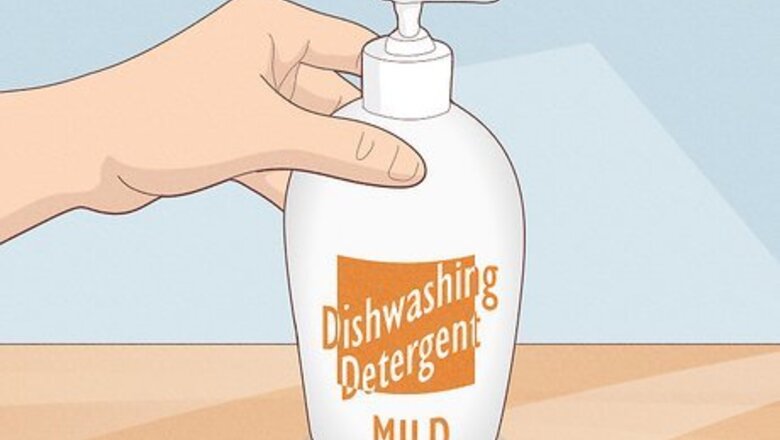
views
Handwashing Your Dog's Food or Water Dish
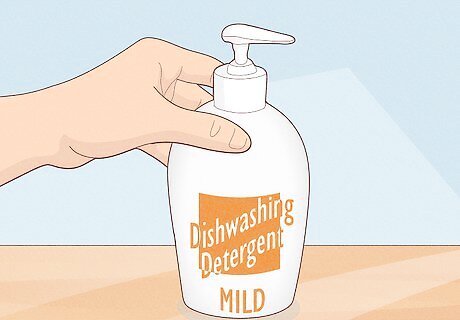
Choose a mild detergent. If you prefer hand wash your dog's food or water dish (rather than than put them in the dishwasher), choose a mild, non-toxic dishwashing detergent. If you are not sure which detergents are mild, check the product labels for indications that the product would be soft on your hands. If the detergent is mild enough for you, then it will be mild enough for your dog's food or water dish. Organic detergents, although more expensive, likely contain non-toxic ingredients. Harsh detergents and bleach are toxic to dogs. You can also make your own mild detergent by combining equal parts of baking soda, warm water, and table salt.

Select a place to clean the food or water dish. It is not recommended to wash your dog's dishes in the bathtub or kitchen sink because of the risk of cross-contamination. Your dog's food or water dish could have bacteria from his mouth and his food, and you would not want that bacteria contaminating the dishes you and your family use. Instead, use a bathroom sink or large utility sink. If you choose to use the kitchen sink, you will need to disinfect it after washing your dog's food or water dish.

Hand wash the food or water dish. To hand wash the dishes, use a dishcloth or sponge that you use only for your dog's dishes. Make the water as hot as you can tolerate. Consider wearing gloves while handwashing to protect your hands from the hot water. Using a circular motion with the dishtowel or sponge, wash both the inside and outside of the dish. Pay special attention to areas where the food has hardened.
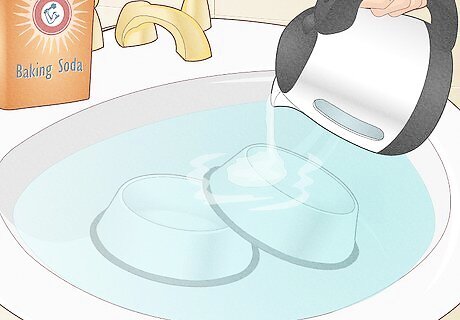
Disinfect the food or water dish. Using hot water and mild detergent is a very effective way to clean your dog's food or water dishes. However, a slimy substance called biofilm can accumulate in your dog's dishes. It contains a combination of bacteria, algae, and fungi that could make your dog sick if he ingests it. Scrubbing and disinfecting the dish are the best ways to get rid of the biofilm and its harmful microorganisms. Biofilm's slimy, gluey texture can make it challenging to remove. The baking soda in your homemade detergent is abrasive enough to remove the biofilm. To disinfect the dish after scrubbing it, mix one gallon of water with one tablespoon of bleach. Add this mixture to the dish and let it sit for about two minutes before rinsing it out. Disinfect the outside of the bowl, too. To make your dog's food or dish extra clean, you can clean and disinfect it, rather than doing one or the other.
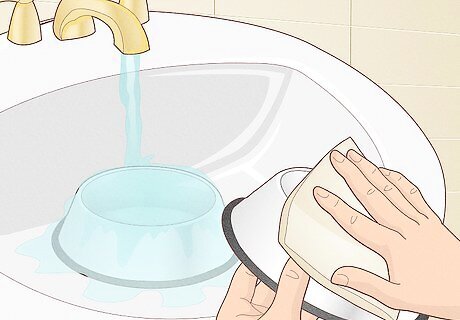
Rinse and dry the food or water dish completely. Your dog could become sick if he ingests detergent residue in his dish, so it is very important for you to rinse his dish completely with water. You can either dry the dish off with some paper towels or let the dish air dry before refilling it with food or water. If you have disinfected the dish, it is very important to rinse away any bleach residue. If you choose to dry off the dish with a dishtowel, make sure the dishtowel is used only for your dog's dishes.
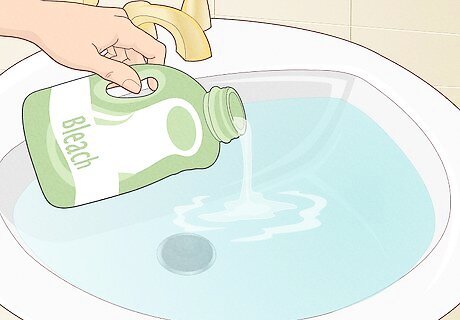
Disinfect the sink. If you have used the kitchen sink, get it ready for human use again by disinfecting it with diluted bleach (one tablespoon or bleach per one gallon of water). Put the stopper in place and fill the sink with the bleach. Let the mixture sit for about five minutes. Next, release the stopper to drain the sink. Finally, give the sink another quick rinse and let it air dry.
Cleaning Your Dog's Food or Water Dish in the Dishwasher

Place your dog's food and water dishes in the dishwasher. Washing your dog's food and water dishes in the dishwasher is preferable, since the water gets hot enough (140 degrees F/60 degrees C) to remove and kill bacteria. In addition, cleaning the dishes in the dishwasher is a great alternative if you do not have much time for handwashing. Even with a pair of cleaning gloves, your hands would probably not be able to tolerate water that is as hot as the water in your dishwasher.

Clean your dog's dishes separately. To prevent cross-contamination, it is preferable to wash your dog's dishes by themselves in the dishwasher. If you decide to wash them separately, consider purchasing several dishes so you can fill and run the dishwasher every few days. It may not be practical for you to wash just one or two of your dog's dishes in the dishwasher at a time.
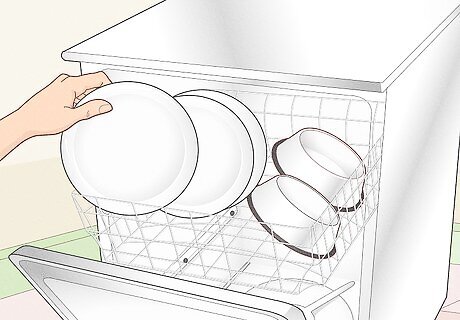
Clean your dog's dishes with your own dishes. It may make you a little squeamish to put your dog's food and water dishes in with your own bowls and plates. However, it may be okay to do so if you have a 'sanitize' setting on your dishwasher. This setting would effectively kill and remove all bacteria, thus preventing cross-contamination. If you are not comfortable combining the dishes, run separate dishwasher loads. Whether you have a combined load or separate loads, select the hottest temperature setting on your dishwasher.
Learning Basic Cleaning Tips
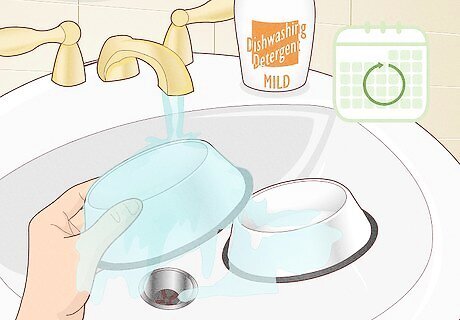
Clean your dog's food or water dish every day. Daily cleanings of your dog's food or water dish are an important step in keeping your dog healthy. Depending on what you feed him, you may have to clean his food dish multiple times a day. For example, if you feed him wet food only, a combination of wet and dry food, or raw food, clean his food dish after each meal. If you feed your dog only dry food, then cleaning the food dish once a day may be sufficient. If you have outdoor dogs, or use one water dish for multiple dogs, clean that dish several times a day. If your dog's food and water dishes feel particularly slimy, consider cleaning the food dish after each meal and the water dish twice daily. Food and water dishes can also accumulate saliva, dust, and debris. In addition to possibly making your dog sick, he may not even want to eat or drink out of the dishes if they look too dirty.

Inspect the food or water dish for scratches. Not all food or water dishes can withstand frequent washing. Over time, less durable dishes can develop scratches in which bacteria could grow and make your dog sick. When you have cleaned the food or water dishes, look them over closely for scratches. Replace any scratched dishes. Stainless steel and porcelain dishes are very durable and can handle frequent cleaning. Ceramic and plastic dishes are not good choices because they are very porous and can harbor bacteria. In addition, plastic dishes get scratches very easily.
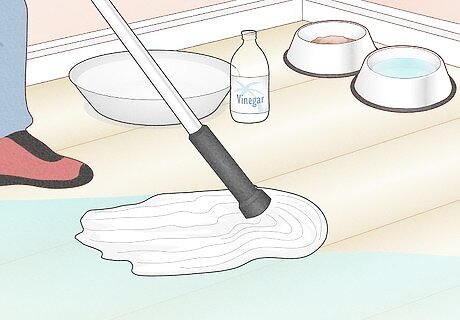
Clean the area around your dog's food and water dishes. It is not enough to keep your dog's food and water dishes clean—the area around his eating area needs to be clean, too. To clean the floor in that area, mix together equal parts vinegar and water and mop the area every few days. Alternatively, you could place a rubber food mat under the dishes to collect excess food and water. Wipe down or hand wash the food mat each day to keep it clean and prevent bacterial growth.




















Comments
0 comment